Evaluating Environmental Sustainability in Early Childhood Education
VerifiedAdded on 2019/10/31
|8
|1400
|279
Homework Assignment
AI Summary
This assignment delves into the critical topic of environmental sustainability education within early childhood settings. It explores the multifaceted nature of sustainability, extending beyond mere conservation to encompass equity and intergenerational responsibility. The assignment evaluates curriculum practices, emphasizing the importance of small, incremental steps in cultivating sustainable habits among young children, such as turning off lights, and waste management. It details the process of designing and planning an environmental sustainability curriculum, advocating for collaborative efforts, hands-on workshops, and child-centered discussions. The curriculum design emphasizes participatory approaches and practical implementation, including in-service training, the integration of creative educational tools, and green cleaning practices. The assignment also evaluates the effectiveness of curriculum learning experiences, highlighting the success of planned and unplanned learning methods, and the crucial involvement of parents, teachers, and children in making the curriculum successful. Furthermore, it underscores the importance of respecting animals and implementing recycling programs.
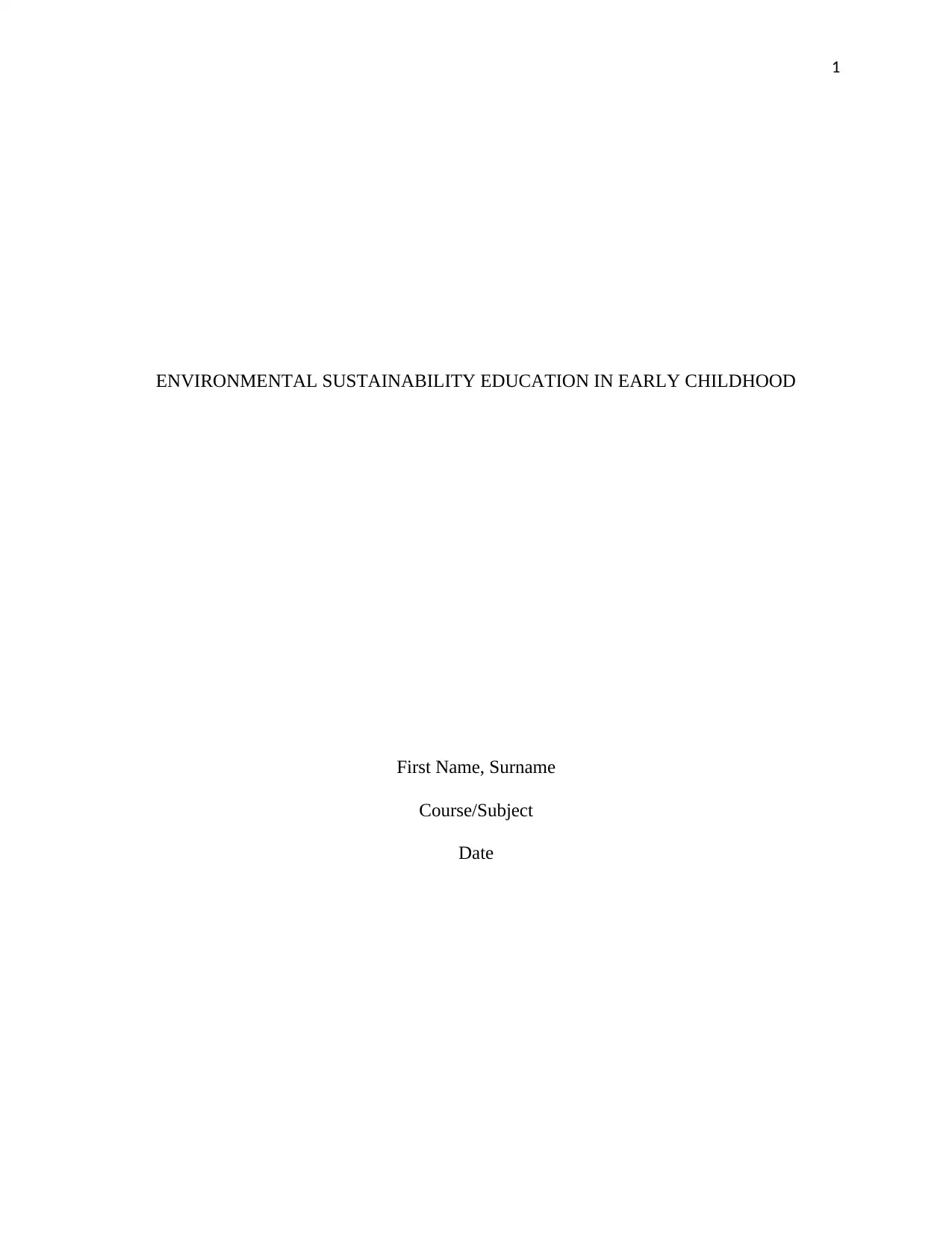
1
ENVIRONMENTAL SUSTAINABILITY EDUCATION IN EARLY CHILDHOOD
First Name, Surname
Course/Subject
Date
ENVIRONMENTAL SUSTAINABILITY EDUCATION IN EARLY CHILDHOOD
First Name, Surname
Course/Subject
Date
Paraphrase This Document
Need a fresh take? Get an instant paraphrase of this document with our AI Paraphraser
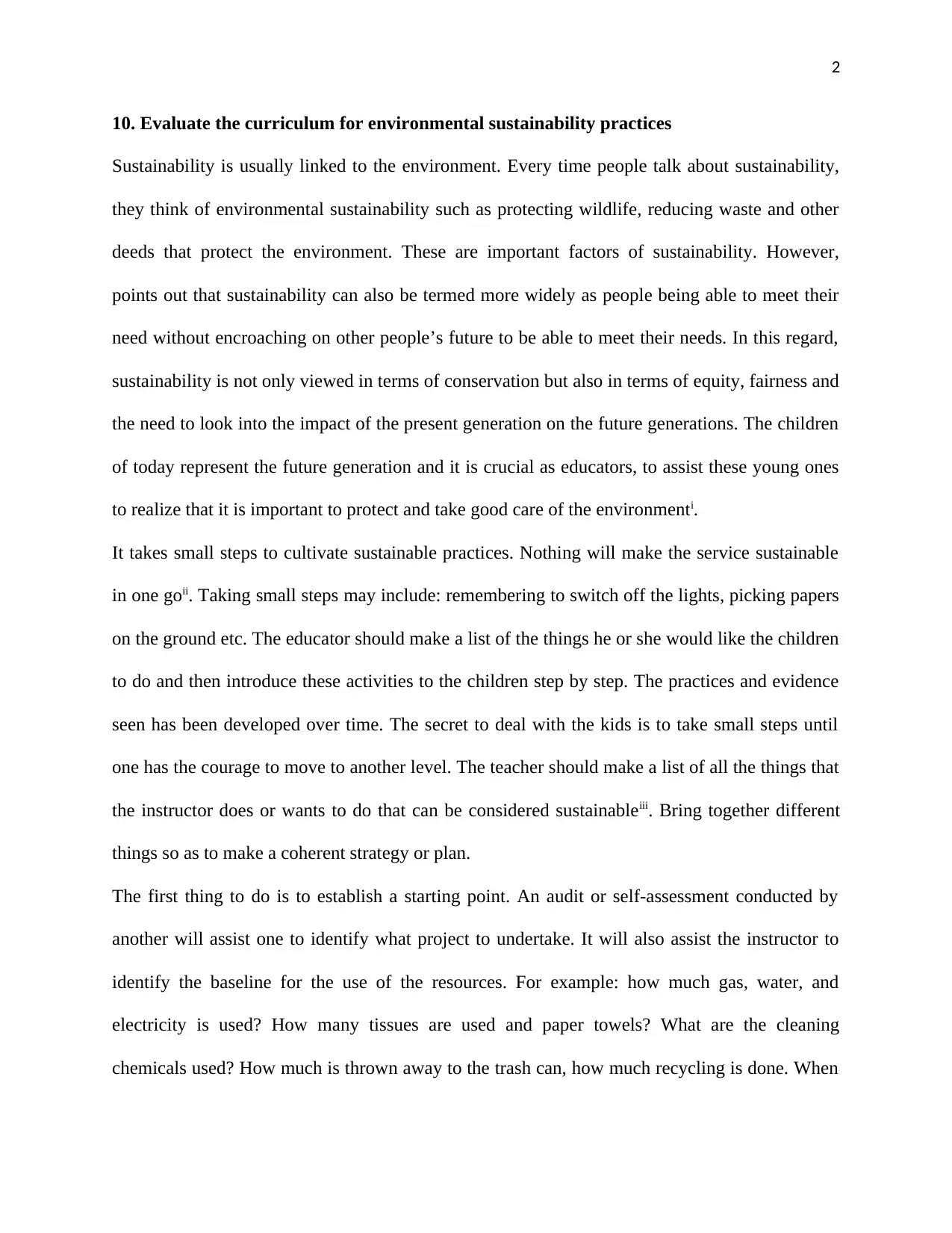
2
10. Evaluate the curriculum for environmental sustainability practices
Sustainability is usually linked to the environment. Every time people talk about sustainability,
they think of environmental sustainability such as protecting wildlife, reducing waste and other
deeds that protect the environment. These are important factors of sustainability. However,
points out that sustainability can also be termed more widely as people being able to meet their
need without encroaching on other people’s future to be able to meet their needs. In this regard,
sustainability is not only viewed in terms of conservation but also in terms of equity, fairness and
the need to look into the impact of the present generation on the future generations. The children
of today represent the future generation and it is crucial as educators, to assist these young ones
to realize that it is important to protect and take good care of the environmenti.
It takes small steps to cultivate sustainable practices. Nothing will make the service sustainable
in one goii. Taking small steps may include: remembering to switch off the lights, picking papers
on the ground etc. The educator should make a list of the things he or she would like the children
to do and then introduce these activities to the children step by step. The practices and evidence
seen has been developed over time. The secret to deal with the kids is to take small steps until
one has the courage to move to another level. The teacher should make a list of all the things that
the instructor does or wants to do that can be considered sustainableiii. Bring together different
things so as to make a coherent strategy or plan.
The first thing to do is to establish a starting point. An audit or self-assessment conducted by
another will assist one to identify what project to undertake. It will also assist the instructor to
identify the baseline for the use of the resources. For example: how much gas, water, and
electricity is used? How many tissues are used and paper towels? What are the cleaning
chemicals used? How much is thrown away to the trash can, how much recycling is done. When
10. Evaluate the curriculum for environmental sustainability practices
Sustainability is usually linked to the environment. Every time people talk about sustainability,
they think of environmental sustainability such as protecting wildlife, reducing waste and other
deeds that protect the environment. These are important factors of sustainability. However,
points out that sustainability can also be termed more widely as people being able to meet their
need without encroaching on other people’s future to be able to meet their needs. In this regard,
sustainability is not only viewed in terms of conservation but also in terms of equity, fairness and
the need to look into the impact of the present generation on the future generations. The children
of today represent the future generation and it is crucial as educators, to assist these young ones
to realize that it is important to protect and take good care of the environmenti.
It takes small steps to cultivate sustainable practices. Nothing will make the service sustainable
in one goii. Taking small steps may include: remembering to switch off the lights, picking papers
on the ground etc. The educator should make a list of the things he or she would like the children
to do and then introduce these activities to the children step by step. The practices and evidence
seen has been developed over time. The secret to deal with the kids is to take small steps until
one has the courage to move to another level. The teacher should make a list of all the things that
the instructor does or wants to do that can be considered sustainableiii. Bring together different
things so as to make a coherent strategy or plan.
The first thing to do is to establish a starting point. An audit or self-assessment conducted by
another will assist one to identify what project to undertake. It will also assist the instructor to
identify the baseline for the use of the resources. For example: how much gas, water, and
electricity is used? How many tissues are used and paper towels? What are the cleaning
chemicals used? How much is thrown away to the trash can, how much recycling is done. When

3
the instructor evaluates, all these factors, he or she can determine which steps to take so as to
conserve the environment for example, opening windows instead of using fans, turning off the
tapsiv. After a while and depending on the resources, one may consider other forms of
sustainability such as installing solar panels and water tanks. The instructor should talk to
families including children and come up with a shared view of what sustainability is and how to
do it. The instructor should be realistic by starting small. For example he or she may start with a
vegetable garden and a worm farm as a start of the project. The project should be meaningful.
Sustainability should be an ongoing process not a one-time experience. To be successful, the
project has to be rooted into a day-to-day basis. To involve the children, find out how the
children should be involved in the sustainability practices of day to day and outline the things
that are done in the school or surrounding and what else they can do.
17. Design an environmental sustainability initiative to include into practice
A well designed programme for environmental sustainability in an early childhood environment
will require a collaborative effort with Local Authority to provide essentials such as kits for
education. The educators will require regular hands-on workshops where they can test
sustainability education activities.
Teacher should engage the children in the discussions towards the environmental sustainable
projects. For example, the teacher can narrate how and when a garbage can is full, how to empty
food and left overs.
Encourage the children to take part in programs for recycling, for example, plastic paper and
bins. They can be taught how to come up with new recycling material such as art and craft and
/or donating some of these materials to the cleanup companies.
the instructor evaluates, all these factors, he or she can determine which steps to take so as to
conserve the environment for example, opening windows instead of using fans, turning off the
tapsiv. After a while and depending on the resources, one may consider other forms of
sustainability such as installing solar panels and water tanks. The instructor should talk to
families including children and come up with a shared view of what sustainability is and how to
do it. The instructor should be realistic by starting small. For example he or she may start with a
vegetable garden and a worm farm as a start of the project. The project should be meaningful.
Sustainability should be an ongoing process not a one-time experience. To be successful, the
project has to be rooted into a day-to-day basis. To involve the children, find out how the
children should be involved in the sustainability practices of day to day and outline the things
that are done in the school or surrounding and what else they can do.
17. Design an environmental sustainability initiative to include into practice
A well designed programme for environmental sustainability in an early childhood environment
will require a collaborative effort with Local Authority to provide essentials such as kits for
education. The educators will require regular hands-on workshops where they can test
sustainability education activities.
Teacher should engage the children in the discussions towards the environmental sustainable
projects. For example, the teacher can narrate how and when a garbage can is full, how to empty
food and left overs.
Encourage the children to take part in programs for recycling, for example, plastic paper and
bins. They can be taught how to come up with new recycling material such as art and craft and
/or donating some of these materials to the cleanup companies.
⊘ This is a preview!⊘
Do you want full access?
Subscribe today to unlock all pages.

Trusted by 1+ million students worldwide
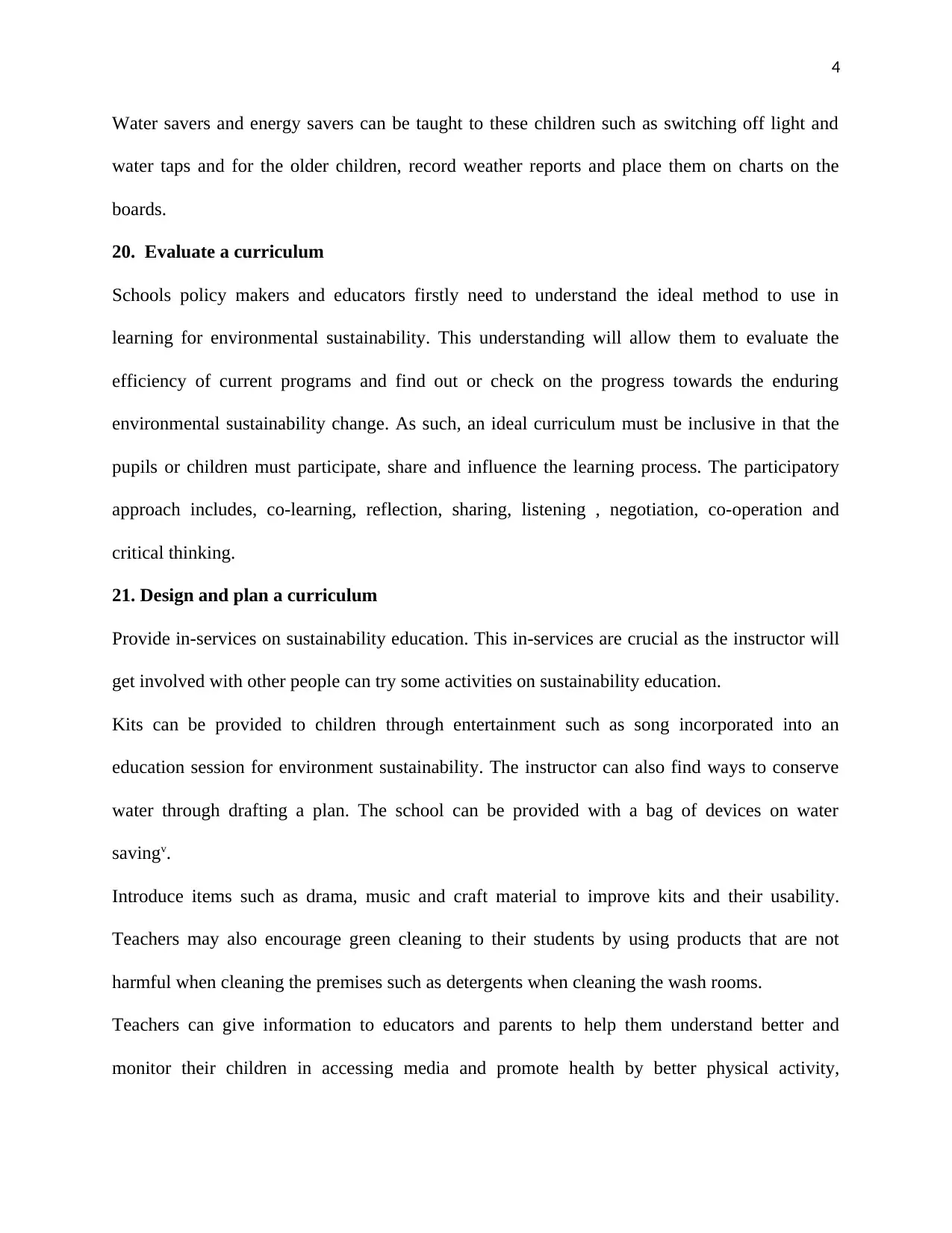
4
Water savers and energy savers can be taught to these children such as switching off light and
water taps and for the older children, record weather reports and place them on charts on the
boards.
20. Evaluate a curriculum
Schools policy makers and educators firstly need to understand the ideal method to use in
learning for environmental sustainability. This understanding will allow them to evaluate the
efficiency of current programs and find out or check on the progress towards the enduring
environmental sustainability change. As such, an ideal curriculum must be inclusive in that the
pupils or children must participate, share and influence the learning process. The participatory
approach includes, co-learning, reflection, sharing, listening , negotiation, co-operation and
critical thinking.
21. Design and plan a curriculum
Provide in-services on sustainability education. This in-services are crucial as the instructor will
get involved with other people can try some activities on sustainability education.
Kits can be provided to children through entertainment such as song incorporated into an
education session for environment sustainability. The instructor can also find ways to conserve
water through drafting a plan. The school can be provided with a bag of devices on water
savingv.
Introduce items such as drama, music and craft material to improve kits and their usability.
Teachers may also encourage green cleaning to their students by using products that are not
harmful when cleaning the premises such as detergents when cleaning the wash rooms.
Teachers can give information to educators and parents to help them understand better and
monitor their children in accessing media and promote health by better physical activity,
Water savers and energy savers can be taught to these children such as switching off light and
water taps and for the older children, record weather reports and place them on charts on the
boards.
20. Evaluate a curriculum
Schools policy makers and educators firstly need to understand the ideal method to use in
learning for environmental sustainability. This understanding will allow them to evaluate the
efficiency of current programs and find out or check on the progress towards the enduring
environmental sustainability change. As such, an ideal curriculum must be inclusive in that the
pupils or children must participate, share and influence the learning process. The participatory
approach includes, co-learning, reflection, sharing, listening , negotiation, co-operation and
critical thinking.
21. Design and plan a curriculum
Provide in-services on sustainability education. This in-services are crucial as the instructor will
get involved with other people can try some activities on sustainability education.
Kits can be provided to children through entertainment such as song incorporated into an
education session for environment sustainability. The instructor can also find ways to conserve
water through drafting a plan. The school can be provided with a bag of devices on water
savingv.
Introduce items such as drama, music and craft material to improve kits and their usability.
Teachers may also encourage green cleaning to their students by using products that are not
harmful when cleaning the premises such as detergents when cleaning the wash rooms.
Teachers can give information to educators and parents to help them understand better and
monitor their children in accessing media and promote health by better physical activity,
Paraphrase This Document
Need a fresh take? Get an instant paraphrase of this document with our AI Paraphraser
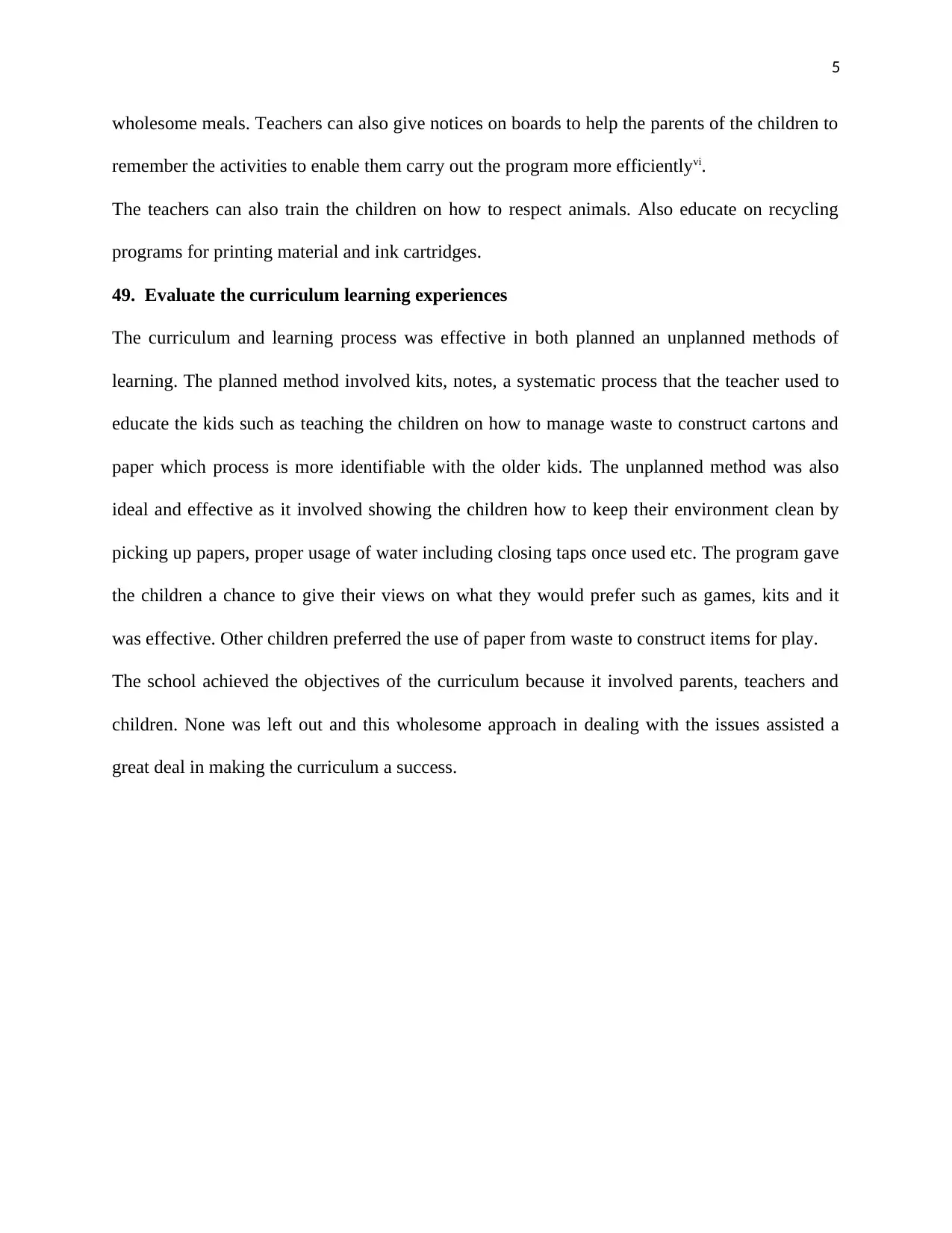
5
wholesome meals. Teachers can also give notices on boards to help the parents of the children to
remember the activities to enable them carry out the program more efficientlyvi.
The teachers can also train the children on how to respect animals. Also educate on recycling
programs for printing material and ink cartridges.
49. Evaluate the curriculum learning experiences
The curriculum and learning process was effective in both planned an unplanned methods of
learning. The planned method involved kits, notes, a systematic process that the teacher used to
educate the kids such as teaching the children on how to manage waste to construct cartons and
paper which process is more identifiable with the older kids. The unplanned method was also
ideal and effective as it involved showing the children how to keep their environment clean by
picking up papers, proper usage of water including closing taps once used etc. The program gave
the children a chance to give their views on what they would prefer such as games, kits and it
was effective. Other children preferred the use of paper from waste to construct items for play.
The school achieved the objectives of the curriculum because it involved parents, teachers and
children. None was left out and this wholesome approach in dealing with the issues assisted a
great deal in making the curriculum a success.
wholesome meals. Teachers can also give notices on boards to help the parents of the children to
remember the activities to enable them carry out the program more efficientlyvi.
The teachers can also train the children on how to respect animals. Also educate on recycling
programs for printing material and ink cartridges.
49. Evaluate the curriculum learning experiences
The curriculum and learning process was effective in both planned an unplanned methods of
learning. The planned method involved kits, notes, a systematic process that the teacher used to
educate the kids such as teaching the children on how to manage waste to construct cartons and
paper which process is more identifiable with the older kids. The unplanned method was also
ideal and effective as it involved showing the children how to keep their environment clean by
picking up papers, proper usage of water including closing taps once used etc. The program gave
the children a chance to give their views on what they would prefer such as games, kits and it
was effective. Other children preferred the use of paper from waste to construct items for play.
The school achieved the objectives of the curriculum because it involved parents, teachers and
children. None was left out and this wholesome approach in dealing with the issues assisted a
great deal in making the curriculum a success.
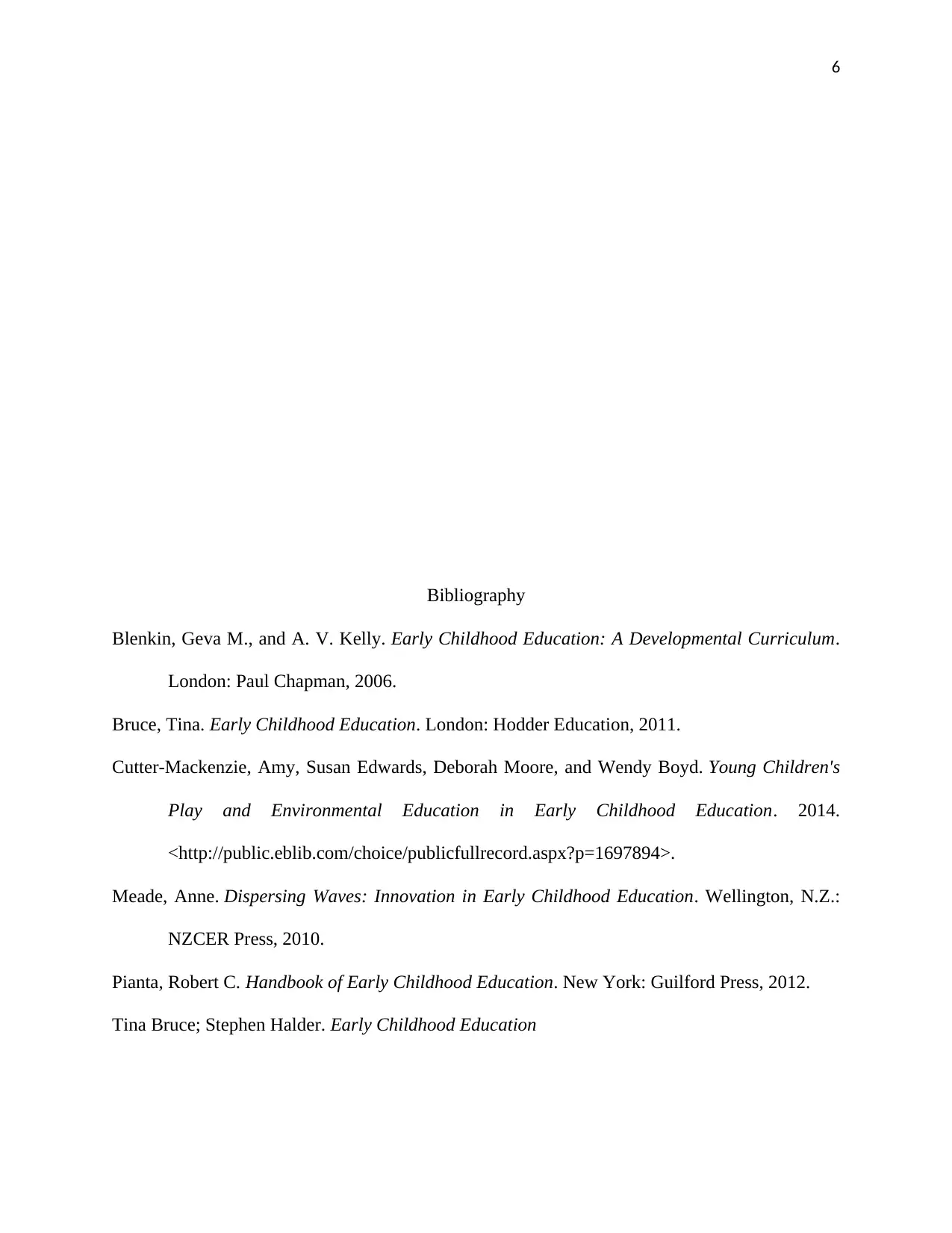
6
Bibliography
Blenkin, Geva M., and A. V. Kelly. Early Childhood Education: A Developmental Curriculum.
London: Paul Chapman, 2006.
Bruce, Tina. Early Childhood Education. London: Hodder Education, 2011.
Cutter-Mackenzie, Amy, Susan Edwards, Deborah Moore, and Wendy Boyd. Young Children's
Play and Environmental Education in Early Childhood Education. 2014.
<http://public.eblib.com/choice/publicfullrecord.aspx?p=1697894>.
Meade, Anne. Dispersing Waves: Innovation in Early Childhood Education. Wellington, N.Z.:
NZCER Press, 2010.
Pianta, Robert C. Handbook of Early Childhood Education. New York: Guilford Press, 2012.
Tina Bruce; Stephen Halder. Early Childhood Education
Bibliography
Blenkin, Geva M., and A. V. Kelly. Early Childhood Education: A Developmental Curriculum.
London: Paul Chapman, 2006.
Bruce, Tina. Early Childhood Education. London: Hodder Education, 2011.
Cutter-Mackenzie, Amy, Susan Edwards, Deborah Moore, and Wendy Boyd. Young Children's
Play and Environmental Education in Early Childhood Education. 2014.
<http://public.eblib.com/choice/publicfullrecord.aspx?p=1697894>.
Meade, Anne. Dispersing Waves: Innovation in Early Childhood Education. Wellington, N.Z.:
NZCER Press, 2010.
Pianta, Robert C. Handbook of Early Childhood Education. New York: Guilford Press, 2012.
Tina Bruce; Stephen Halder. Early Childhood Education
⊘ This is a preview!⊘
Do you want full access?
Subscribe today to unlock all pages.

Trusted by 1+ million students worldwide

7
End notes
End notes
Paraphrase This Document
Need a fresh take? Get an instant paraphrase of this document with our AI Paraphraser
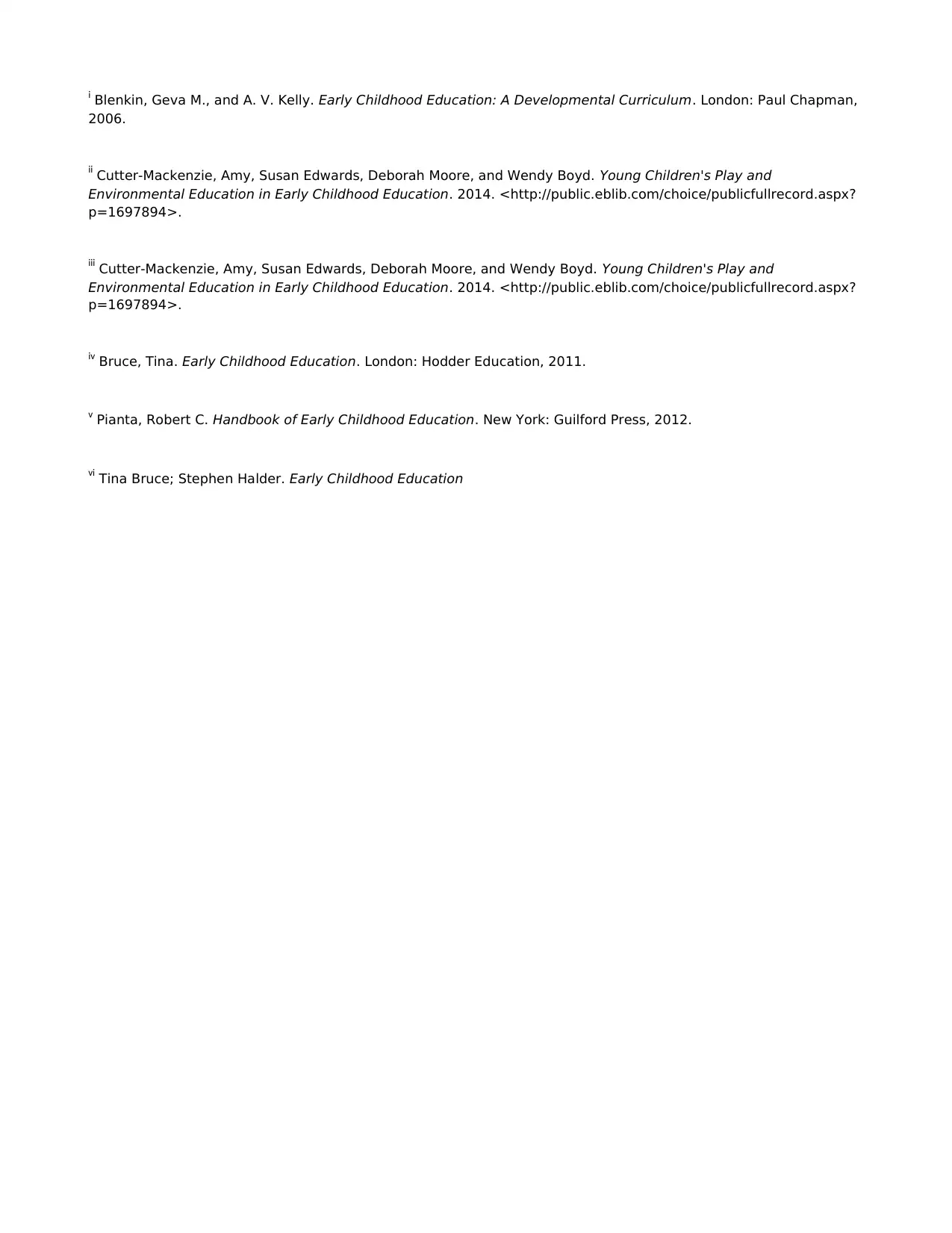
i Blenkin, Geva M., and A. V. Kelly. Early Childhood Education: A Developmental Curriculum. London: Paul Chapman,
2006.
ii Cutter-Mackenzie, Amy, Susan Edwards, Deborah Moore, and Wendy Boyd. Young Children's Play and
Environmental Education in Early Childhood Education. 2014. <http://public.eblib.com/choice/publicfullrecord.aspx?
p=1697894>.
iii Cutter-Mackenzie, Amy, Susan Edwards, Deborah Moore, and Wendy Boyd. Young Children's Play and
Environmental Education in Early Childhood Education. 2014. <http://public.eblib.com/choice/publicfullrecord.aspx?
p=1697894>.
iv Bruce, Tina. Early Childhood Education. London: Hodder Education, 2011.
v Pianta, Robert C. Handbook of Early Childhood Education. New York: Guilford Press, 2012.
vi Tina Bruce; Stephen Halder. Early Childhood Education
2006.
ii Cutter-Mackenzie, Amy, Susan Edwards, Deborah Moore, and Wendy Boyd. Young Children's Play and
Environmental Education in Early Childhood Education. 2014. <http://public.eblib.com/choice/publicfullrecord.aspx?
p=1697894>.
iii Cutter-Mackenzie, Amy, Susan Edwards, Deborah Moore, and Wendy Boyd. Young Children's Play and
Environmental Education in Early Childhood Education. 2014. <http://public.eblib.com/choice/publicfullrecord.aspx?
p=1697894>.
iv Bruce, Tina. Early Childhood Education. London: Hodder Education, 2011.
v Pianta, Robert C. Handbook of Early Childhood Education. New York: Guilford Press, 2012.
vi Tina Bruce; Stephen Halder. Early Childhood Education
1 out of 8
Related Documents
Your All-in-One AI-Powered Toolkit for Academic Success.
+13062052269
info@desklib.com
Available 24*7 on WhatsApp / Email
![[object Object]](/_next/static/media/star-bottom.7253800d.svg)
Unlock your academic potential
Copyright © 2020–2025 A2Z Services. All Rights Reserved. Developed and managed by ZUCOL.




